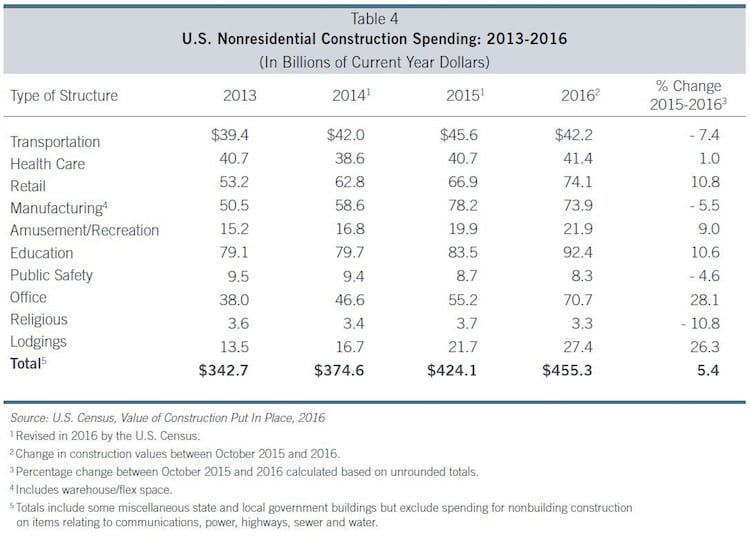Commercial real estate development in Colorado supports 45,897 related jobs and contributes $5.88 billion to the state’s economy, according to an annual study published by NAIOP Research Foundation.
The NAIOP study showed development, construction and ongoing operations of new commercial real estate in the United States – office, industrial, warehouse and retail – generates significant economic growth at the state and national levels, supporting 6.25 million American jobs and contributing $861 billion to U.S. gross domestic product in 2016.
Colorado ranked ninth in the nation for warehouse/flex development, including e-commerce distribution and fulfillment facilities.
The annual study, Economic Impacts of Commercial Real Estate, measures the contributions to GDP, salaries and wages generated, and jobs created and supported from the development and operations of commercial real estate.
 Nationwide, there were 410 million square feet of office, retail, warehouse and industrial built in 2016, with capacity to house more than 1 million new workers with a total estimated payroll of $57.6 billion.
Nationwide, there were 410 million square feet of office, retail, warehouse and industrial built in 2016, with capacity to house more than 1 million new workers with a total estimated payroll of $57.6 billion.
“The importance of commercial development to the U.S. economy is well established, and the industry’s growth is critical to creating new jobs, improving infrastructure, and creating places to work, shop and play,” said Thomas Bisacquino, NAIOP president and CEO. “Commercial real estate is a robust contributor to national and state economies, and NAIOP is dedicated to working with the administration, Congress and state legislators to develop bipartisan infrastructure investment and incentives for capital investment that empowers our industry to expand.”
Construction Spending Continues to Increase
A key factor in the economy’s growth in 2016 was the continuing expansion of the construction sector. Construction spending has increased each year since 2011, gaining 48.7 percent between 2011 and October 2016. For the year ending in October 2016, total construction spending was up 3.4 percent, exceeding the GDP growth rate for this period.
Office construction expenditures totaled $36.6 billion in 2016, increasing by 28.7 percent from 2015.
Retail construction expenditures totaled $17.2 billion in 2016, a decrease of 7 percent from gains of 8.2 percent in 2015.
Warehouse construction totaled $13.6 billion in 2016, registering a sixth consecutive year of increased expenditures and gaining 12.7 percent from 2015.
Industrial construction spending decreased sharply for a second year in 2016 to $15.5 billion, declining 29.9 percent from 2015. This pullback in industrial/manufacturing construction in 2016 and 2015 can be attributed to the downturn in the energy sector and a weakening in global demand for U.S. manufactured goods due largely to unfavorable exchange rates with the U.S.’s major trading partners, NAIOP said.
By compensating for slower-growing sectors, the construction sector’s gains will provide the foundation that should extend the economy’s expansion into the next decade, making it the longest business cycle in history. The report notes that if the economy avoids recession through mid-2020, it would tie the previous longest business cycle record of 10 years, achieved in the 1980s.
The report is authored by economist Stephen S. Fuller, Ph.D., Dwight Schar faculty chair, university professor and director, Stephen S. Fuller Institute, Schar School of Policy and Government at George Mason University, Arlington, Virginia. Data was provided by Dodge Data & Analytics.
The full report includes detailed data on commercial real estate development activity in all 50 states, including the direct spending; total output; salaries and wages; and jobs supported.
The full report is online: naiop.org/contributions2017.












